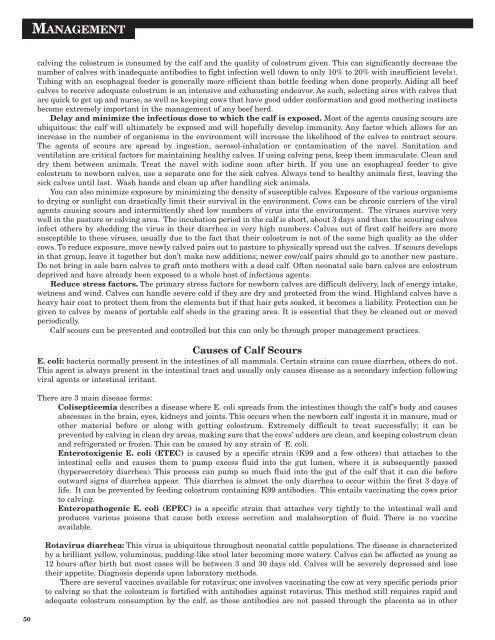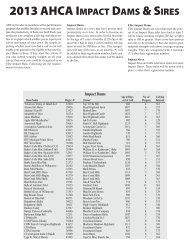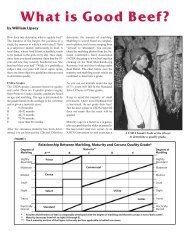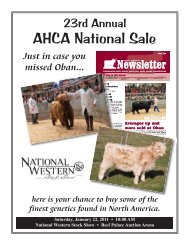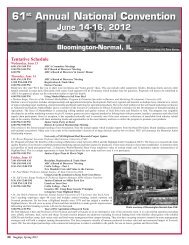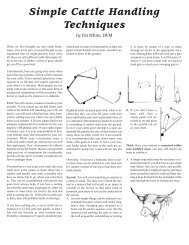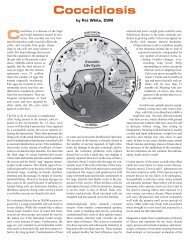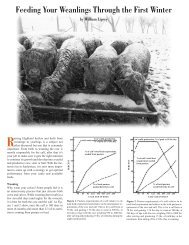The Bagpipe - American Highland Cattle Association
The Bagpipe - American Highland Cattle Association
The Bagpipe - American Highland Cattle Association
You also want an ePaper? Increase the reach of your titles
YUMPU automatically turns print PDFs into web optimized ePapers that Google loves.
50<br />
MANAGEMENT<br />
calving the colostrum is consumed by the calf and the quality of colostrum given. This can significantly decrease the<br />
number of calves with inadequate antibodies to fight infection well (down to only 10% to 20% with insufficient levels).<br />
Tubing with an esophageal feeder is generally more efficient than bottle feeding when done properly. Aiding all beef<br />
calves to receive adequate colostrum is an intensive and exhausting endeavor. As such, selecting sires with calves that<br />
are quick to get up and nurse, as well as keeping cows that have good udder conformation and good mothering instincts<br />
become extremely important in the management of any beef herd.<br />
Delay and minimize the infectious dose to which the calf is exposed. Most of the agents causing scours are<br />
ubiquitous: the calf will ultimately be exposed and will hopefully develop immunity. Any factor which allows for an<br />
increase in the number of organisms in the environment will increase the likelihood of the calves to contract scours.<br />
<strong>The</strong> agents of scours are spread by ingestion, aerosol-inhalation or contamination of the navel. Sanitation and<br />
ventilation are critical factors for maintaining healthy calves. If using calving pens, keep them immaculate. Clean and<br />
dry them between animals. Treat the navel with iodine soon after birth. If you use an esophageal feeder to give<br />
colostrum to newborn calves, use a separate one for the sick calves. Always tend to healthy animals first, leaving the<br />
sick calves until last. Wash hands and clean up after handling sick animals.<br />
You can also minimize exposure by minimizing the density of susceptible calves. Exposure of the various organisms<br />
to drying or sunlight can drastically limit their survival in the environment. Cows can be chronic carriers of the viral<br />
agents causing scours and intermittently shed low numbers of virus into the environment. <strong>The</strong> viruses survive very<br />
well in the pasture or calving area. <strong>The</strong> incubation period in the calf is short, about 3 days and then the scouring calves<br />
infect others by shedding the virus in their diarrhea in very high numbers. Calves out of first calf heifers are more<br />
susceptible to these viruses, usually due to the fact that their colostrum is not of the same high quality as the older<br />
cows. To reduce exposure, move newly calved pairs out to pasture to physically spread out the calves. If scours develops<br />
in that group, leave it together but don’t make new additions; newer cow/calf pairs should go to another new pasture.<br />
Do not bring in sale barn calves to graft onto mothers with a dead calf. Often neonatal sale barn calves are colostrum<br />
deprived and have already been exposed to a whole host of infectious agents.<br />
Reduce stress factors. <strong>The</strong> primary stress factors for newborn calves are difficult delivery, lack of energy intake,<br />
wetness and wind. Calves can handle severe cold if they are dry and protected from the wind. <strong>Highland</strong> calves have a<br />
heavy hair coat to protect them from the elements but if that hair gets soaked, it becomes a liability. Protection can be<br />
given to calves by means of portable calf sheds in the grazing area. It is essential that they be cleaned out or moved<br />
periodically.<br />
Calf scours can be prevented and controlled but this can only be through proper management practices.<br />
Causes of Calf Scours<br />
E. coli: bacteria normally present in the intestines of all mammals. Certain strains can cause diarrhea, others do not.<br />
This agent is always present in the intestinal tract and usually only causes disease as a secondary infection following<br />
viral agents or intestinal irritant.<br />
<strong>The</strong>re are 3 main disease forms:<br />
Colisepticemia describes a disease where E. coli spreads from the intestines though the calf’s body and causes<br />
abscesses in the brain, eyes, kidneys and joints. This occurs when the newborn calf ingests it in manure, mud or<br />
other material before or along with getting colostrum. Extremely difficult to treat successfully; it can be<br />
prevented by calving in clean dry areas, making sure that the cows’ udders are clean, and keeping colostrum clean<br />
and refrigerated or frozen. This can be caused by any strain of E. coli.<br />
Enterotoxigenic E. coli (ETEC) is caused by a specific strain (K99 and a few others) that attaches to the<br />
intestinal cells and causes them to pump excess fluid into the gut lumen, where it is subsequently passed<br />
(hypersecretory diarrhea). This process can pump so much fluid into the gut of the calf that it can die before<br />
outward signs of diarrhea appear. This diarrhea is almost the only diarrhea to occur within the first 3 days of<br />
life. It can be prevented by feeding colostrum containing K99 antibodies. This entails vaccinating the cows prior<br />
to calving.<br />
Enteropathogenic E. coli (EPEC) is a specific strain that attaches very tightly to the intestinal wall and<br />
produces various poisons that cause both excess secretion and malabsorption of fluid. <strong>The</strong>re is no vaccine<br />
available.<br />
Rotavirus diarrhea: This virus is ubiquitous throughout neonatal cattle populations. <strong>The</strong> disease is characterized<br />
by a brilliant yellow, voluminous, pudding-like stool later becoming more watery. Calves can be affected as young as<br />
12 hours after birth but most cases will be between 3 and 30 days old. Calves will be severely depressed and lose<br />
their appetite. Diagnosis depends upon laboratory methods.<br />
<strong>The</strong>re are several vaccines available for rotavirus; one involves vaccinating the cow at very specific periods prior<br />
to calving so that the colostrum is fortified with antibodies against rotavirus. This method still requires rapid and<br />
adequate colostrum consumption by the calf, as these antibodies are not passed through the placenta as in other


